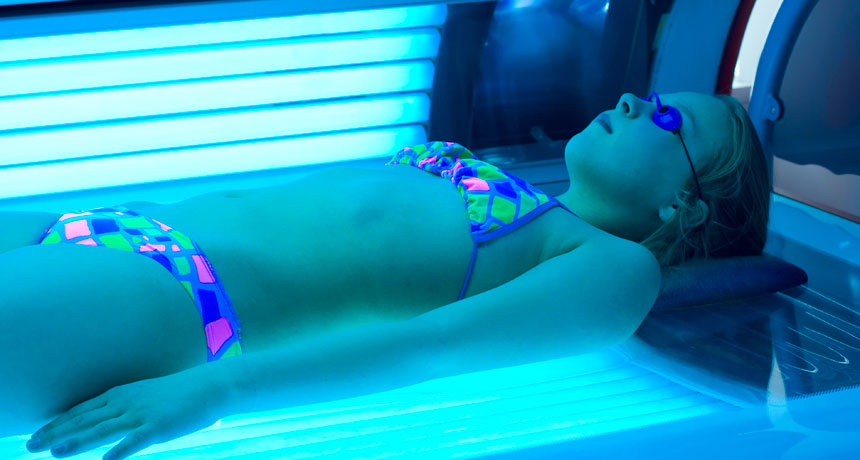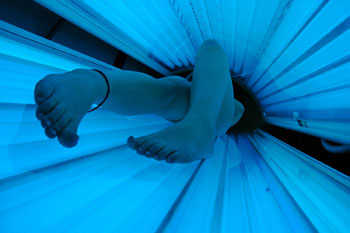FDA wants to ban indoor tanning by teens
Ultraviolet light used to tan can increase the risk of skin cancer

To prompt the skin to tan, tanning beds use ultraviolet radiation. But too much of it can cause skin cancer. Children are especially vulnerable to UV’s effects.
Vigold/istockphoto
In the average U.S. city, there are more tanning salons than Starbucks. More than 1 million people visit them every day. But sitting under tanning-bed lights increases the risk of skin cancer, especially in children. Now, the U.S. Food and Drug Administration has proposed a new rule that would prevent anyone under the age of 18 from indoor tanning.
Almost one-third of all white, non-Hispanic, high-school girls in the United States have used a tanning salon in the past year. The salon’s light bulbs emit ultraviolet (UV) radiation that leaves users with a sun-kissed glow. Sunlight contains the same wavelengths. Indeed, the sun’s UV radiation is responsible for natural tanning — and sunburns. But the lamps used by tanning beds can expose skin to 10 times as much of this radiation, per minute, as natural sunlight can. And studies have shown that people who start tanning when they’re young can increase their risk of skin cancer by 75 percent. The biggest concern is the cancer known as melanoma (Mel-ah-NO-mah). It’s especially deadly.
That’s why the FDA wants to limit the amount of ultraviolet radiation to which children are exposed. Sophie Balk thinks that’s a really good thing. She’s a pediatrician at the Children’s Hospital at Montefiore in Bronx, N.Y. “We have information that the younger you start and the more you tan, the higher the risk [of skin cancer],” says Balk. And, she adds, research suggests that “as a young person, your skin may be more susceptible to the effects of these harmful rays.”
FDA published its new proposal on December 22. The restrictions would be similar to those banning the sale of cigarettes to children, says Jerod Stapleton. He’s a prevention scientist at the Rutgers Cancer Institute of New Jersey in New Brunswick. He studies how people’s behavior can affect their risk of certain diseases. And when it comes to UV radiation and skin cancer, the answer is clear, he says: “There’s really no such thing as a safe tan.”

Sixteen states, as well as many cities and counties, have created various forms of tanning-salon restrictions for kids under 18. But the proposed FDA rule would create a national policy. It would prohibit tanning-salon visits everywhere in the country by anyone under 18. Right now, it’s just a proposal. People have three months to send comments to the FDA. After that, the agency could turn the proposal into a final rule, enforceable by law.
Power Words
(for more about Power Words, click here)
Food and Drug Administration (or FDA) A part of the U.S. Department of Health and Human Services, FDA is charged with overseeing the safety of many products. For instance, it is responsible for making sure drugs are properly labeled, safe and effective; that cosmetics and food supplements are safe and properly labeled; and that tobacco products are regulated.
cancer Any of more than 100 different diseases, each characterized by the rapid, uncontrolled growth of abnormal cells. The development and growth of cancers, also known as malignancies, can lead to tumors, pain and death.
melanoma A type of cancer that starts in pigment-making cells called melanocytes, usually in the skin.
pediatrics A field of medicine that has to do with children and especially child health. A doctor who works in this field is known as a pediatrician.
radiation (in physics) One of the three major ways that energy is transferred. (The other two are conduction and convection.) In radiation, electromagnetic waves carry energy from one place to another. Unlike conduction and convection, which need material to help transfer the energy, radiation can transfer energy across empty space.
ultraviolet A portion of the light spectrum that is close to violet but invisible to the human eye.
wavelength The distance between one peak and the next in a series of waves, or the distance between one trough and the next. Visible light — which, like all electromagnetic radiation, travels in waves — includes wavelengths between about 380 nanometers (violet) and about 740 nanometers (red). Radiation with wavelengths shorter than visible light includes gamma rays, X-rays and ultraviolet light. Longer-wavelength radiation includes infrared light, microwaves and radio waves.







